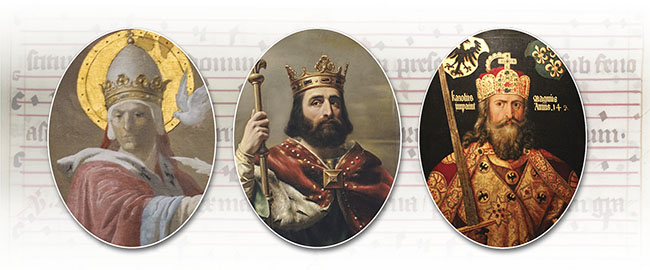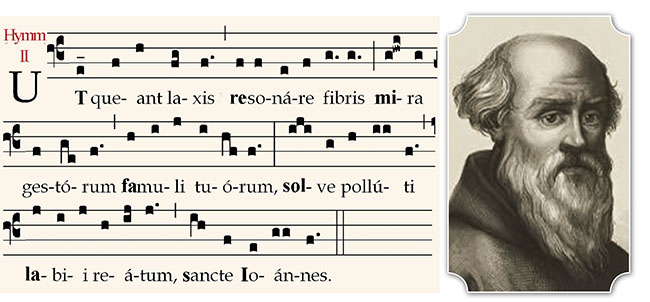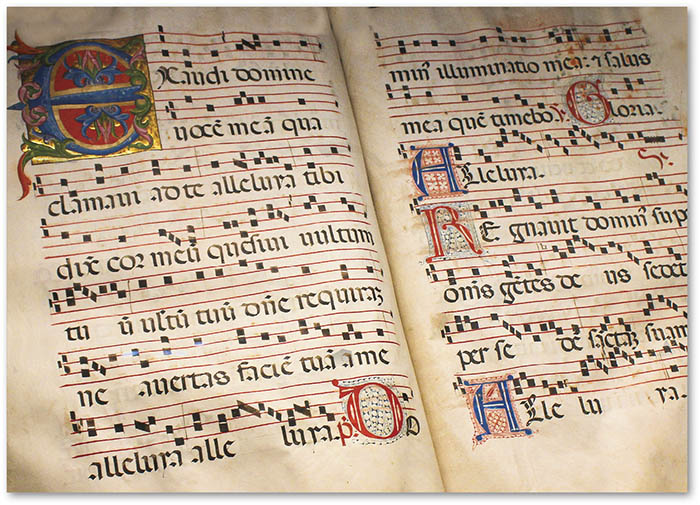Conductor Kurt Pahlen, a famous Austrian musicologist and composer, was once asked how he would define music. The maestro confessed that the question surprised him, but in order not to leave it unanswered, he said: “To the prosaic, Music is an acoustic phenomenon; to the professionals, it is a technical problem of melody, harmony and rhythm; but for those who truly love it with all their heart, music is an expression of the soul, which can elevate us to the infinite and which contains all human feelings.”1
Pahlen was referring to music as a whole, as art. However, there is one style of music that this definition fits particularly well: Gregorian chant.
How is Gregorian chant defined?
A technical answer to such a question would be the following: it is monodic, diatonic, modal and free rhythm music… But, what do these terms ultimately mean? Let’s consider each one of them.
Monodic. Unlike polyphony, in Gregorian chant, all the voices sing a single melody.
Diatonic. Gregorian chant uses only the diatonic scale, made up of the natural sequence of sounds, with only one accidental, the B flat.
Modal. It is known that modern music uses all the sounds of the musical scale, but it is the final note, the note of repose, known as the tonic, which defines its tonality. Gregorian chant is not tonal, but modal, that is to say, it is the sequence of tones and semitones within the scale that defines its mode or particular form.
Free rhythm. The notes of the Gregorian staff do not have an absolute measured value, as in modern music. Their fundamental value consists in what we call simple time or syllabic time, which is indivisible.
However, these four characteristics do not fully answer our question, because Gregorian chant means something more: it is the official liturgical chant of the Catholic Church, in the Latin rite, and therefore the one that is used publicly for the purpose of praising God and obtaining the sanctification of the faithful, the aim of the Liturgy. In fact, just as the devil makes use of the human senses in tempting man, so the Church can stimulate man to the practice of virtue through those same senses, as for example through hearing.
Moreover, Gregorian chant symbolizes the unity and sanctity of the Church: unity because it makes use of a single melody and language, Latin; sanctity because it uses texts, for the most part, from Sacred Scripture. These two aspects make it the religious music par excellence in the West, in the strictest sense of the expression.
A poor, chaste and obedient chant
According to Dom Jean Claire, choir master of Solesmes Abbey between 1975 and 2000, Gregorian chant, so to speak, “professes” the three religious vows:
That of poverty, because it is simple, monodic; in it unity prevails. Moreover, it does not need instrumental accompaniment.
That of Chastity, because it does not arouse disordered passions in man, but rather invites to peace of mind and serenity, reflects the sacred and nourishes faith.
That of obedience, since its raison d’être consists in serving the liturgical text. The melody is subordinate to the lyrics, which carry a mystical and spiritual message.
Gregorian chant is, therefore, a sung prayer, a true dialogue with the Creator and an act of praise to Him, in a manner comparable to verbal incense. In the definition of Dr. Plinio Corrêa de Oliveira, it is the form of “music that has the incomparable quality of expressing the perfect attitude, the exact degree of light of the upright and truly innocent soul when it stands before God.”2
Most scholars agree in dividing the history of Gregorian chant into four periods or eras. Let us have a brief look at each of them.
The formation period
In the middle of the first century, St. Paul went to Rome and brought to the Christian communities melodies of Hebrew origin that he knew from the synagogue and which were gradually adapted to the new religion. In this legacy, the custom of singing the Psalms occupies an important place.
Later, during the second and third centuries, the Roman Church would adopt in its worship ritual elements from other regions, such as Syria, Asia Minor and Byzantium, as well as the Greek language. In other words, ecclesiastical chant in the first three centuries brought together melodies from different cultures.
From the year 313, with the end of the persecutions and the recognition of Christianity as a religion on an equal footing with the other cults in the empire, the Church began a process of liturgical-musical formation of its own, using elements from three cultures: the Sacred Books of the Jews, the modal system and the theoretical and technical progress of the Greeks, the language, poetry and metrics of the verses of the Romans. This process gave rise to what is called Ancient Roman chant.
In this new context, churches were built in various places and celebrations acquired greater splendour. Later, in the most important centres of Christianity, the evolution of their own liturgical rites would give rise to the Ambrosian, Mozarabic, and Gallic rites, among others, which would coexist during several centuries.
Apogee and diffusion
At the end of the sixth century, the one who would lend his name to the official liturgical chant of the Church rose to the papal throne: St. Gregory the Great. This Pope certainly composed some melodies, but his principal task was to reform and perfect the chants that already existed, to select and order the pieces, giving each one its place in the liturgical cycle. He also founded the Schola Cantorum, with the intention of training people in this style of sacred music, who would go on to spread their knowledge to other regions of medieval Christendom.
In the middle of the 8th century, the liturgical chant of Rome entered Gaul at the request of the Frankish sovereign Pepin the Short, who intended to replace Gallican chant. However, what actually happened was a fusion of the two. The Roman repertoire imposed its text, style and modal structure, but clothed with the embellishment of Gallican chants. The result was what we might call Franco-Roman chant, which a century later would be given the name Gregorian in honour of Pope St. Gregory.
Later, in the context of the Carolingian Renaissance, it would become officially widespread in the empire by an ordinance of Charlemagne, thus replacing the styles which existed alongside the Gregorian. Various schools of chant were founded, which constituted a form of apostolate and a means of establishing a single style of liturgical chant.

At left, St. Gregory the Great – Cathedral of St. George, Ferrara (Italy); centre, Pepin the Short; at right, Charlemagne, by Albrecht Dürer – Museum of Hofburg, Vienna; in background, a score from the Moosburger Gradual
The Gregorian score is born
Gregorian chant enjoyed great expansion and its repertoire grew which, as a consequence, necessitated the creation a system of written notation that would help singers to remember the melodies, which until then were transmitted orally. This innovation took place in the middle of the 9th century.
Initially, only neumes appeared, signs placed above the text as a means of giving some indication as to the movements of the melody. Although this system entailed a certain difficulty in knowing the exact intervals between the notes – because they were signs written in campo aperto, in an open, unlined space – it still signified an undeniable advance.
To solve the problem of the exact pitch of sounds, lines were added, representing certain notes in the scale, which served to identify the notes next to them. First a red line was inserted to designate the fa note, and later a second yellow line, to indicate do. Finally, a third line was introduced between the two previous ones, representing la.
Together with the appearance of the first neumes, the tropes were born, which designated the insertion of texts below the notes of a melisma – many notes sung on the same syllable – with the intention of helping in the memorization of the melodies.
In the course of time, the use of this technique would lead to certain exaggerations. What was initially applied to the melodies of the Kyrie and Alleluia, little by little took over all pieces to which melismas could be applied.
From the 9th century onwards, the first attempts at polyphonic music also began to appear, and shortly afterwards liturgical drama was born: the staging of sacred texts during major celebrations such as Easter and Christmas.

Hymn to St. John the Baptist used by Guido d’Arezzo to name the notes. The si (usually ti in English) is formed combining the initials of “Sancte Ionannes”; later, the name “ut” became do
Then came the great reformer and innovator of Western music, the Benedictine monk Guido d’Arezzo, who instituted the tetragram for the Gregorian staff and inserted the C and F clefs, thus allowing the alteration of note length.
Another innovation he introduced was the nomenclature of the notes, which until then were identified according to the Greek alphabetical method: A (la), B (ti), C (do), D (re), E (mi), F (fa) and G (sol). Based on a hymn to St. John the Baptist in which each phrase begins on a degree of the musical scale, Guido named the notes according to the sol-fa system still used today.
In the 12th century, the neumatic symbols were replaced by more square symbols, precursors of modern notation. This writing, known as square notation, solved the problem of the intervals by the more precise positioning of the notes, but it was imperfect from the standpoint of the rhythmic and expressive nuances of the original neumes, since now the same type of sign indicated practically all the notes.

At left, Gregorian score with neumes; at right, Gregorian score with the addition of red and yellow lines
Period of decadence
With the evolution of polyphony, mensural notation also arose: determined time values for the notes, as well as the use of bars and pentagrams. This mensural system was even applied to Gregorian chant, progressively abandoning rhythmic traditions and assigning values to the notes in an arbitrary manner. Certain Gregorian melodies were accompanied by other voices, giving rise to the organum paralelum, and some religious orders created their own style. The tropes, born in the previous period, became exaggerated, with sometimes romantic lyrics, which led to their being banned in the Latin rite, together with the sequences – a set of verses with a certain symmetry – during the Council of Trent.3 In short, the chant had lost its original purity.
In this context it is important to clarify that such decadence was due, not to the development of polyphony, as if this were a bad style of music in itself, but to the progressive disuse of the Gregorian, considered by many as an antiquated chant in comparison with the new compositions.
Restoration
A phase of revitalization began with Dom Prosper Guéranger, abbot of Solesmes between 1837 and 1875. In his endeavour to restore monastic life, interrupted for some decades as a result of the French Revolution, he initiated a process of recovering the true spirit of Gregorian chant. He put into motion the revision and comparison of manuscripts in various monasteries in Europe, so as to restore their original meaning through palaeographic and semiotic efforts. Photography greatly facilitated this task and some works were published with the results of the research. As is to be expected, there were objectors, but the Benedictines imposed themselves scientifically, thus ensuring the cause of Gregorian restoration.
In 1903 St. Pius X published the Motu proprio Tra le sollecitudini, on sacred music. That same year he entrusted a specialized commission, based on the work of Solesmes, with an official publication called the Vatican Edition, which would publish works such as the Graduale in 1907 and the Antiphonale in 1912, with the use of Gregorian square notation and the addition of auxiliary elements: a supplementary lower and upper line, episema, custos, dots, asterisks, and commas.
The same Pope founded the Pontifical Institute of Sacred Music in 1910. Later Pontiffs ratified the norms of St. Pius X and other institutes were opened in Europe.
Among the Benedictines who stood out in the work of restoring Gregorian chant were Dom Joseph Pothier, Dom André Mocquereau and Dom Eugène Cardine, who published important works in the field of Gregorian music.
Spiritual music par excellence
After this brief incursion into the spirituality and history of Gregorian chant, we come to the conclusion that it is the spiritual form of music par excellence.
To perform it well demands not only talent, but above all piety and humility, since the sonorous union of the singers is a symbol of the intermingling of all the faithful who come together to worship God.
In singing, we must be conscious of the need to do so in the key of prayer, for in this way we will perform an act of divine praise. ◊
Taken from the Heralds of the Gospel magazine, #190.
Notes
1 PAHLEN, Kurt. Historia gráfica universal de la música. 2.ed. Buenos Aires: Centuriones, 1944, p.32.
2 CORRÊA DE OLIVEIRA, Plinio. Pináculo da expressão religiosa [Pinnacle of Religious Expression]. In: Dr. Plinio. São Paulo. Year IX. N.102 (Sept., 2006); p.4.
3 The Council of Trent authorized only four sequences for liturgical use: Victimæ paschali laudes, on Easter Sunday; Veni Sancte Spiritus, on the Solemnity of Pentecost; Lauda Sion, on the Solemnity of Corpus Christi; and Dies iræ, at the Mass of the Dead. In the 18th century the Stabat Mater was added at the Mass of Our Lady of Sorrows.


